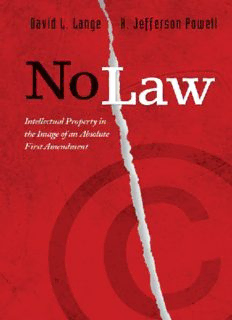
No Law: Intellectual Property in the Image of an Absolute First Amendment PDF
Preview No Law: Intellectual Property in the Image of an Absolute First Amendment
N O L A W N O L A W Intellectual Property in the Image of an Absolute First Amendment David L. Lange and H. Jefferson Powell stanford law books An Imprint of Stanford University Press Stanford, California © 2009 David L. Lange and H. Jefferson Powell. All rights reserved. No part of this book may be reproduced or transmitted in any form or by any means, electronic or mechanical, including photocopying and recording, or in any information storage or retrieval system without prior written permission. Printed in the United States of America on acid- free, archival- quality paper Library of Congress Cata loging- in- Publication Data Lange, David, 1938– No law : intellectual property in the image of an absolute First Amendment / David L. Lange and H. Jefferson Powell. p. cm. Includes bibliographical references and index. ISBN 978-0-8047-4578-9 (cloth : alk. paper)—ISBN 978-0-8047-4579-6 (pbk. : alk. paper) 1. Intellectual property—United States. 2. United States. Constitution. 1st Amendment. 3. Freedom of expression—United States. I. Powell, Jefferson, 1954– II. Title. KF2979.L37 2008 346.7304'8—dc22 2008011828 Typeset by Westchester Book Group in 10/15 Sabon For my wife and companion, Teresa—creative, expressive, and wise, and always the better writer. —D. L. For my daughter Sara, whose enthusiastic interest makes writing a joy. —J. P. Contents Preface ix Ac know ledg ments xiii part i intellectual property in america: the idea and its merits 1 Unfair Competition and Trademarks 3 2 Patents, Copyright, and Neighboring Rights 34 3 Exclusivity versus Appropriation: Some Questions and Costs 65 4 “Exclusive Rights” and the Constitution 108 part ii intellectual productivity and freedom of expression 5 Foreshadowings: International News Ser vice v. Associated Press 149 6 Intellectual Productivity and Freedom of Expression: The Conditions of Their Coexistence 168 contents part iii the first amendment in america: some chapters in a history of debate 7 The Origins of the First Amendment and the Question of Original Meaning 195 8 The Sedition Act of 1798 and the First First Amendment Crisis 212 9 Justice Holmes and the Arrival of Balancing 225 10 Justice Black and the Absolute First Amendment 239 part iv the absolute first amendment revisited: the amendment as a prohibition on power 11 Constitutional Absolutes in a Holmesian World 263 12 Forward to the Eigh teenth Century 284 part v summing up 13 Intellectual Property in the Image of an Absolute First Amendment 305 Notes 327 Bibliographic Note 417 Errata and Apocrypha 419 Index 421 viii Preface our book had its beginnings in a series of conversations some years ago between its authors, who are friends and colleagues on the fac- ulty of the Law School at Duke University.* Professor Lange, whose professional interests include intellectual property and entertainment law, has long been identifi ed with specialists in these fi elds who are skep- tical of the utility and the impact of the doctrines that limit freedom of expression. Professor Powell has written extensively on subjects centered in the history and theories of interpretation affecting the American Con- stitution. Meanwhile, each of us has had a par ticu l ar interest in the First Amendment that antedated the conversations that led to this work. As our conversations continued, we decided to record our growing conviction that the notions of exclusivity traditionally associated with the intellectual property doctrines of greatest concern in the context of expression (chiefl y copyright, but also some aspects of unfair competi- tion, moral rights, trademark law, and even patent law) ought to be constrained in favor of a far wider and more complete susceptibility of that expression to unlicensed appropriation by others. This we thought, in company with many others who had written on the subject, was at least minimally necessary in the interest of creative expression. In truth, however, we were soon convinced that exclusive rights in any e xpression—whether conventionally creative or not—were simply intol- erable in a system of law that prizes the right in individuals to think as they please and to speak as they think—the system of law that Ameri- cans (and American courts) like to pride themselves in possessing. As we * The question of voice is a per sis tent one in coauthored works. We have elected to write in the fi rst person, singular or plural, whenever that is feasible, and in the third person when that voice seems most likely to yield clarity or otherwise appears appropri- ate. Regrettably nevertheless, some awkwardness is inevitable, for which we apologize. ix
Description: